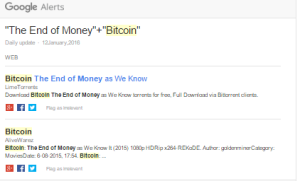Fellow Filmmakers. I haven’t written much on this blog for a while. This case study is about what I have been up to for the past 18 months and my learnings about crowdfunding documentaries and self-distribution in the process. Here is all the data in great detail. This article also explains how my film ended up being the most pirated documentary on the Internet.
The Idea:
– Experience of working with filmmakers and factual content for about 5 years.
– Indirectly or directly involved with hundreds of documentaries.
– I am passionate about Technology and have a strong interest in Finance (I wrote a paper about alternative currencies during my MBA program).
– When Bitcoin came along it seemed like a good topic for a documentary. It’s too complex to explain in an article or a 3 minute conversation.
– Controversial topic. Some hailing it as “the biggest thing since the Internet” while others claim that it’s “a Ponzi scheme”.
– Very passionate community. Clearly defined target audience: 90% Male. Age 20-35. Tech savvy.
– Additional to myself, the team included Michael Watchulonis (an award-winning filmmaker and director who helped me with all technical aspects as well as with the writing and all of the editing) and an industry expert who is very well connected in the Bitcoin and FinTech space.
– Chose a provocative title which raises questions/curiosity: “Bitcoin: The End Of Money As We Know It”
Crowdfunding Campaign:
– Produced a number of interviews and a “punchy” trailer prior to the campaign
– Chose Kickstarter. Click here to see the campaign.
– Campaigning is a full-time job for 6-8 weeks.
– Understood that crowdfunding is less about the actual money but about gathering a community and a base of loyal fans.
– Asked for a relatively small amount of $10,000. Never intended to cover all production costs.
– Reached the goal early and 174% in total. That’s about $15,500 after fees and commission.

– Most popular rewards were the lower tiers

– Mid-tier rewards included a clever giveaways like authentic 10 Trillion Dollar banknotes from Zimbabwe
– The rest of the budget (approx. 70%) was self-funded
– Campaigning was largely done via social media and within the existing Bitcoin community
– Campaign success also functioned as ‘proof of concept’.
Documentary Production:
– Produced the film in standard High Definition. Recorded interviews in 6 cities on 3 continents.
– Licensed hundreds of clips for B-Roll (tracking down, licensing, obtaining, monitoring it would turn out to be a major time and cost factor). Used footage services and existing network of friends in the industry. Many Bitcoin users and companies provided useful footage for free.
– To save costs, we used royalty free music and kept custom animations limited
– Delivered film behind schedule and above initial budget (just like every first time filmmaker)
– Post-production milestones were submission dates for film festivals
Pre-Release Activities
– Crowdsourced the design of our poster/key art via 99Designs. 125 designs were submitted. See all variations here. Polled our fanbase for their favorite design and decided on this one:
– Built a strong following on Twitter
– Released a new trailer on YouTube. About 20,000 views pre-release (51,000 views as of today)

– Mistake: not clearly communicating a definite launch date
– Built a strong presence on Reddit. 1,500 Upvotes and 500 comments
– Won three awards at festivals in Amsterdam and Las Vegas
– Handling film festivals via services such as withoutabox or filmfreeway is efficient but investment in time and money is high. We stopped after a few months.
Self Distribution Results (First Month):
– Launchdate July 15th. 80% of transaction in the first 5 days.

– Activity on social media way up


– Facebook Page starts to get traction (1,500 fans as of today)
– Best performing Transactional VOD platform is Vimeo where the social media statistics are very strong compared to almost any other film on their service
– Innovative download package as BitTorrent Bundle generated a lot of traffic but not many transactions
– Great results on small platform that offers pay-with-Bitcoin option
– Reddit was a strong traffic driver
– Interviews and appearances on many many many radio shows and podcasts. Activated 20 promotion codes which (only) yielded 130 transactions (usually 20% off).
– Getting rated and reviewed on imdb is very difficult. Should have encouraged audience earlier. Score started around 9.0 and then made a sudden drop to 7.1 where it is now ‘locked’.

– Upon closer inspection, it is a few bad ratings that pull the weighted average down. The “mean” is still 8.0 and the “Median” 9.

– This is the rating after a few months.

I now understand why almost any film ends up in the 6-7 point range.
– Made the mistake of not launching on iTunes and Amazon at the same time (It takes much longer to onboard on these platforms). Launch date on iTunes (USA) in early August and Amazon Instant Video in mid August. Getting reviews in order to “kickstart” the algorithms there is difficult.
– Local screenings all over the world at community events (Sydney, Santiago de Chile), meetup groups, conferences (London, Amsterdam), and even in traditional movie theatres (Scandinavia, Israel). The free Sydney screening generated 120$ in donations. We are looking for people who want to organize more screenings now.
– Interestingly, more than 20 subtitled versions (Russian, Hindi, Mandarin, Spanish) have appeared on the Internet. Unauthorized but highly appreciated.
Piracy:
– This is a film about a peer-to-peer technology, so the fact that it would get pirated so much is not surprising
– Estimate: About 200,000 illegal (torrent) downloads, making it one of the most popular documentary among pirates in 2015. These are two google alerts from January (seven months after initial release).


– We have seen about 120,000 illegal video streams, mostly on YouTube. Take-down process takes several days. Some of the uploaders are ‘hiding’ the film under a different name which makes it very difficult to detect.
– It is impossible to estimate whether any of these illegal viewers (streamed or downloaded) would have paid for the film. There is some evidence from Hollywood blockbusters that there is little overlap and cannibalisation i.e. pirates do not hurt the legal distribution and might actually help it.
– We estimate that there are also numerous unauthorized public screenings of the film (see USA, Mexico and Indonesia below). I encourage free screenings as it increases the overall popularity of the film and it translates into more imdb ratings, reviews and maybe some legal downloads. However, most of these venues never contacted us in the first place.
Distribution results after 6 months
– Vimeo remains the best platform for us, but after the first weeks the revenue is only at a minimum base level. iTunes was only strong for the first two weeks. Amazon Instant Video is constant/slightly growing.
– On vimeo 15,000 trailer plays resulted in 1,000 transactions. 40% came from the USA. 8% from the UK, and 7% each from Germany and Australia
– On iTunes (USA) 47% of all transactions are rentals, 53% are purchases. 67% are HD transactions which are 1-2$ more expensive than SD
– Weekends are strongest on both vimeo and iTunes. Price promotions or coupon codes have little impact. Bitcoin press coverage in mainstream media (scandals, big investments, price swings) translate into more views.
– Ratio of about 300’000 pirated views to 2’000 paid transactions means that I monetize less than 1% of all views
– Small extra income with screening fees or bulk DVD orders
– 30 donations to our Bitcoin wallet address totalling about 250$
– Some TV channels and film festivals have contacted us; I assume some of them due to the ‘popularity’ of the pirated versions
– We are now starting to place the film for in-flight entertainment (business/finance documentaries perform well in this market) and are actively seeking international sales agents for television.
Conclusions:
– Using cheap sources of B-roll and other footage as well as royalty-free music is crucial unless you have tons of other people’s money to spend
– We need to deliver from idea to finished film much faster and at lower cost
– Narration based docs are less popular with the main buyers (broadcasters); we will consider stronger characters or ‘hosted’ stories in the future
– Self-distribution (B2C) is very difficult and time consuming even if your film is popular and ‘goes viral’; a coordinated big global launch is important (we missed an opportunity)
– We don’t have an indication whether (costly) other language versions would have helped with distribution
– You cannot fight piracy, don’t even try it. Instead, try to use it to your advantage
– Traditional B2B (licensing) distribution is still where most of the revenues are
– We are not convinced that the awards at smaller festivals helped us with distribution. However, we think it’s advisable to submit to festivals that match your core audience in order to gain “street cred” (e.g. we won an award at a Libertarian festival)
– For our next production we would chose a topic that has an equally enthusiastic following and community behind it; it is a good idea to cover topics that are about to become trends
– We will not self-fund another production again and instead rely on traditional funding sources (pre-sales, broadcasters, incentive programs) and substitute this with a crowdfunding campaign






